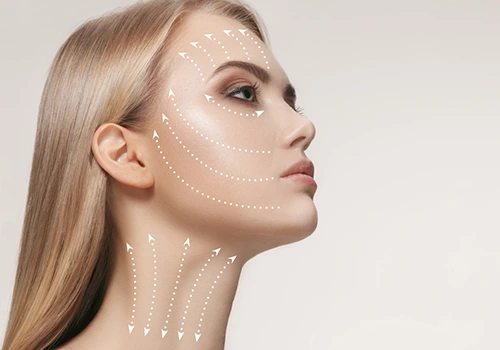Facelift Surgery | Everything about Rhytidectomy
Face Lift Surgery, or Rhytidectomy, is a transformative cosmetic procedure aimed at rejuvenating the face and neck, effectively reversing the visible effects of aging. It acts like a rejuvenating spell, offering a more youthful and revitalized look.
Our faces are our most expressive canvases, reflecting emotions, personality, and health. However, the passage of time may lead to wrinkles, sagging skin, and other age-related signs. In the pursuit of feeling as good as we look, Face Lift has surged in popularity. This is where “Dr. Maadico” steps into action and with our aid, you will have a memorable experience in Iran during your Face Lift Surgery.
This article aims to demystify the world of Face Lift, equipping you with the knowledge needed for an informed decision. Let’s explore the realm of facelifts and uncover how this procedure can be a game-changer in your quest for youthfulness!
What is a Facelift?
Imagine an Anti-aging surgery that can turn back time for your face. That’s essentially what a Face Lift is! This procedure is all about helping you reclaim a youthful look by tightening sagging skin and reducing wrinkles. It’s like hitting the refresh button on your appearance.
During a Face Lift Surgery, a skilled surgeon carefully lifts and repositions the skin and underlying tissues of your face and neck. Any excess skin is trimmed away. The result? A smoother, firmer, and more youthful appearance.
Different Types of Face Lift Surgeries
There isn’t just one-size-fits-all when it comes to Face Lift Surgery. Different techniques have been developed to address specific issues. Here are a few types you might encounter:
- Traditional Face Lift: This is the standard method, perfect for those with significant sagging and aging signs. It involves creating incisions around the ears and sometimes extending into the scalp.
- Mini Face Lift: For those with milder aging signs, the Mini Face Lift is an excellent option. It’s less invasive and involves smaller incisions, resulting in quicker recovery times.
- Thread Lift: Thread Lift is a non-surgical alternative. It involves inserting dissolvable threads under the skin to lift and tighten. While it’s less invasive, the results may not be as long-lasting as with traditional surgery.
- Mid Face Lift: Focusing on the middle of your face, this procedure lifts the cheeks and under-eye area, restoring a more youthful look.
Each type of Face Lift has its unique advantages and is tailored to your specific needs. Your surgeon will help you choose the right one for you.

Candidates for Face Lift Surgery
who’s the perfect fit for a Rhytidectomy? Face Lift is designed for those who want to address the visible signs of aging, like sagging skin and deep wrinkles. It’s not just about looking younger; it’s about feeling more confident and rejuvenated.
Candidates for Face Lift typically:
- Are in good overall health
- Have realistic expectations about the outcomes
- Are bothered by the effects of aging on their face
Before you jump into Facial Rejuvenation, a consultation with a board-certified plastic surgeon is essential. During this consultation, the surgeon will assess your facial characteristics, skin quality, and your specific concerns. They will help you understand what can be achieved through Face Lift Surgery and discuss the best approach for your unique needs. So, if you’re considering a Face Lift, the first step is to consult with an experienced surgeon to determine the best plan for achieving your desired results.
Preparing for Facelift Surgery
Preparing for Face Lift Surgery is crucial to ensure a successful and safe procedure. Here’s a step-by-step guide on how to prepare before the surgery:
- Consultation and Evaluation: Schedule a consultation with your chosen surgeon. During this initial meeting, discuss your goals and concerns openly. Your surgeon will evaluate your facial structure, skin quality, and overall health to determine if you’re a suitable candidate for a Face Lift.
- Medical Assessment: Your surgeon will require a comprehensive medical evaluation, including blood tests, to ensure you’re in good health for the procedure. Be sure to disclose any medical conditions, allergies, medications, or supplements you’re currently taking.
- Set Realistic Expectations: Understand what a Face Lift can and cannot achieve. Your surgeon will discuss the expected outcomes, so be sure to set realistic expectations.
- Smoking and Alcohol: If you smoke, you should quit at least a few weeks before the surgery. Smoking can slow down the healing process and increase the risk of complications. Limit alcohol consumption in the weeks leading up to the surgery as well.
- Medication Adjustments: Follow your surgeon’s instructions regarding medications. You may need to discontinue or adjust certain medications and supplements before the surgery, especially blood-thinning ones.
- Avoid Blood Thinners: Leading up to the surgery, avoid aspirin and non-steroidal anti-inflammatory drugs (NSAIDs) as they can increase the risk of bleeding during and after the procedure.
- Prepare Your Home: Arrange your living space for a comfortable and stress-free recovery. Stock up on groceries, ensure you have a clean and safe environment, and make your recovery area easily accessible.
- Post-Operative Care: Enlist a friend or family member to assist you during the initial days of recovery. You might need help with daily activities, such as cooking, cleaning, and personal care.
- Fasting Before Surgery: Your surgeon will provide specific instructions regarding fasting before the surgery. It’s essential to follow these instructions closely.
- Clothing and Personal Items: Wear comfortable clothing on the day of surgery. Leave valuable items, jewelry, and contact lenses at home. Make sure to bring a clean, loose-fitting outfit for your trip back home.
- Mental Preparation: Mentally prepare yourself for surgery and recovery. Understand that there will be swelling and bruising, and it might take some time to see the final results.
- Follow Pre-Operative Instructions: Your surgeon will provide a list of specific pre-operative instructions. Follow them meticulously to ensure your safety and the success of the procedure.

The Facelift Procedure
The Facelift Procedure steps are as below:
Anesthesia and Incision Techniques
- Anesthesia options include intravenous sedation or general anesthesia.
- The choice depends on the extent of the procedure and your preferences.
- Incisions are carefully planned to minimize scarring.
Lifting and Repositioning Facial Tissues
- Surgeons lift and reposition underlying facial tissues.
- This reshapes facial contours, reducing wrinkles and sagging skin.
Removing Excess Skin
- Surgeons trim away excess skin.
- The remaining skin is redraped to create a smoother, firmer appearance.
Combining Face Lift with Other Procedures
- Facelifts can be combined with other surgeries like eyelid or neck lifts.
- This comprehensive approach addresses multiple aspects of facial aging for harmonious results.
Recovery
After your anti-aging surgery, taking care of yourself is essential for a smooth recovery. Your surgeon will provide specific post-surgery care instructions, which you should follow diligently. These instructions typically cover:
- Wound Care: How to clean and care for your incisions.
- Medication: Taking prescribed pain relievers or antibiotics.
- Diet: Eating a healthy, balanced diet to aid healing.
- Follow-up appointments: Scheduling and attending your follow-up appointments with your surgeon.
Managing Discomfort and Swelling
Expect some discomfort and swelling after your Anti-aging surgery. To manage these:
- Pain Management: Take pain medications as prescribed by your surgeon.
- Swelling Control: Apply cold compresses to reduce swelling, as recommended.
- Rest: Get plenty of rest, keeping your head elevated when sleeping to minimize swelling.
Resuming Daily Activities
You’ll need to take it easy for a while, but you can gradually resume daily activities:
- Walking: Light walks can aid circulation and promote healing.
- Avoid Strenuous Activities: Steer clear of strenuous exercise and heavy lifting until your surgeon gives the green light.
- Returning to Work: The timing varies but expect to be off work for a couple of weeks, depending on your job and the extent of your surgery.
Long-Term Care
Maintaining the results of your Anti-aging surgery involves:
- Sun Protection: Protect your skin from the sun with sunscreen, hats, and sunglasses to prevent premature aging.
- Skincare Routine: A good skincare regimen, including moisturizing and gentle cleansing, can help keep your skin healthy.
- Healthy Lifestyle: Eat well, stay hydrated, and avoid smoking to support long-term facial rejuvenation.

Risks
Face Lift Surgery, like any medical procedure, comes with potential risks. These may include:
- Infection
- Bleeding
- Scarring
- Nerve damage
- Anesthesia complications
How to Minimize Risks of Surgery
To reduce these risks, choose an experienced surgeon, follow pre- and post-op instructions carefully, and maintain good overall health. Your surgeon will take precautions to minimize risks, but being an informed and proactive patient is key to a successful Face Lift Surgery.
Quick Facts about Facelift Surgery
| Operation’s name | Face Lift (Rhytidectomy) |
| Duration | 2-6 hours (Depending on the complexity) |
| Anesthesia | General anesthesia |
| Hospitalization | 1 night |
| Recovery Time | 1-2 week |
| Full Recovery | 6 months and more |
Bottom Line
Making an informed decision about Face Lift Surgery is vital. Research, consult with skilled surgeons, and set realistic expectations to achieve the results you desire.
Face Lift Surgery isn’t just about enhancing your appearance; it’s about boosting your self-confidence and self-esteem. Feeling good about yourself is a valuable aspect of a fulfilling and happy life. So, if you’re considering a Face Lift, remember it’s a journey towards a more confident, rejuvenated you.
If you’re ready for a change, request a free consultation.
You may also be interested in knowing about:
Chin Reshaping
Facial Bone Contouring
Chin Sculpting Procedures
Jawline Surgery
Facial Scar Revision
Cheek Dimple Creation
Forehead Reduction Procedure
Brow Bone Reduction
Buccal Fat Removal
Facial Feminization
Lip Enhancement
Ear Correction
Necklift
FAQs
- Is Facelift Surgery painful?
Discomfort is expected but managed with pain medication as prescribed by your surgeon.
- How long does recovery take?
Initial recovery in about 2 weeks, but complete healing may take several months for optimal results.
- Can I combine a Facelift with other procedures?
Yes, a facelift can be combined with procedures like eyelid surgery or neck lift for comprehensive facial rejuvenation.
- Are the results permanent?
While a facelift can take years off your appearance, the natural aging process continues. Results typically last 5-10 years.
- Is the facelift surgery dangerous for pregnant women?
Face Lift Surgery is not recommended during pregnancy. It’s crucial to wait until after pregnancy and breastfeeding before considering the procedure to ensure safety for both mother and child.



